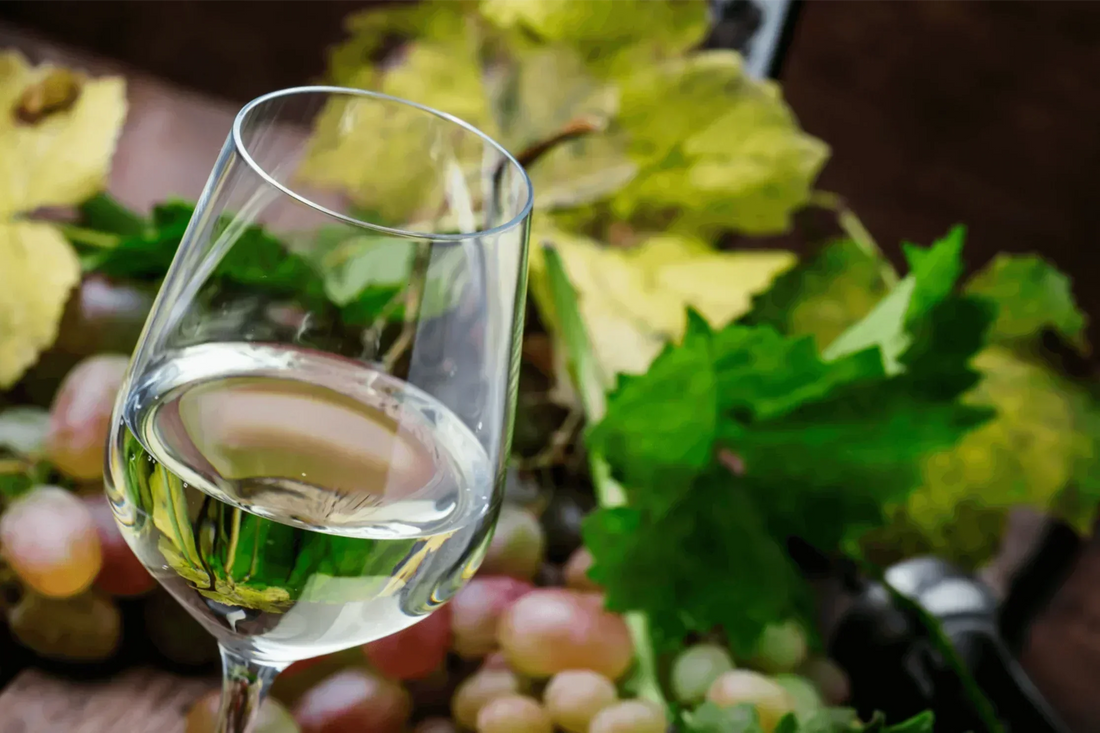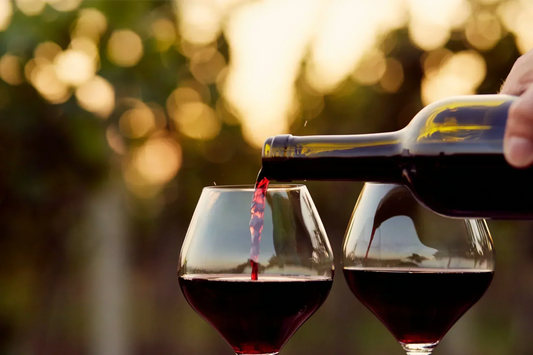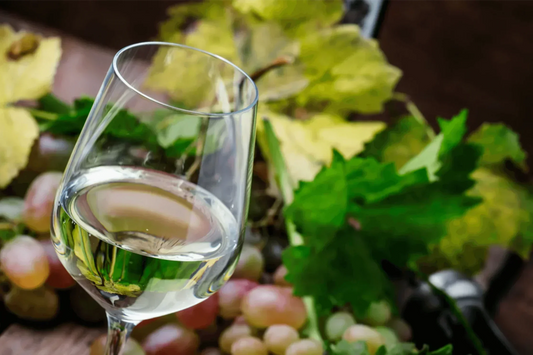
What Is Dry White Wine? Definition, Types & Pairings
Ever wondered what "dry white wine" really means when you see it on a menu? It's a type of wine with little to no residual sugar, which gives it a crisp and refreshing taste instead of a sweet one. Whether it's Sauvignon Blanc, Pinot Grigio, or Chardonnay, dry white wines are incredibly versatile, great for sipping, cooking, or pairing beautifully with your favourite dishes. In this guide, we’ll explore what exactly makes a white wine dry, introduce some popular varieties, and share friendly tips on how to choose and enjoy it just like a seasoned wine enthusiast.
What is a "Dry" White Wine?
A dry white wine is a type of white wine that contains very little residual sugar, usually less than 10 grams per litre, so it tastes crisp, clean, and refreshing rather than sweet. The dryness results from the fermentation process, where natural grape sugars are completely converted into alcohol by yeast. This explains why the same grape variety, such as Riesling, can be produced as either a dry or sweet wine depending on when the fermentation is halted.
Dry white wines are some of the most versatile bottles you’ll find. They range from zesty, citrus-driven Sauvignon Blanc and Pinot Grigio to richer, more complex Chardonnays aged in oak. Due to their balance of acidity and freshness, they are ideal not only for sipping but also for cooking, where they enhance dishes like seafood, chicken, or creamy pasta sauces.
In short, dry white wine means low sugar, high refreshment, and endless pairing possibilities, making it a staple on both wine lists and in home kitchens.
Types of Dry White Wine by Style
| Comparison of Dry White Wine Types | |||||
|---|---|---|---|---|---|
| Type | Flavour Profile | Body & Texture | Best Enjoyed | Ideal Pairings | Popular Varietals |
| Light-Bodied Dry Whites | Bright citrus (lemon, lime), green apple, pear, subtle floral notes | Light, crisp, clean with brisk acidity | Within 1–2 years for a fresh character | Oysters, mussels, light fish, garden salads, chèvre or mozzarella | Pinot Grigio, Albariño/Alvarinho, Muscadet |
| Herbaceous Dry Whites | Lime zest, passion fruit, green bell pepper, cut grass | Medium-bodied, sharp & snappy acidity | Young & vibrant to keep intense aromatics | Grilled asparagus, pesto pasta, scallops, salmon, herbed goat cheese | Sauvignon Blanc |
| Full-Bodied Dry Whites | Baked apple, vanilla, toast, almond, peach, buttery notes | Full, smooth, sometimes creamy with subtle oak | Young or aged for complexity & roundness | Roasted chicken, turkey, cream pasta | Chardonnay, Viognier, White Rioja |
Dry white wines present a variety of styles, each one appealing to different tastes and perfect for many occasions. Let's explore the main types, each shining with its special character.
Light-Bodied Dry Whites
Light-bodied dry whites are valued for their bright acidity, subtle fruit flavours, and crisp, refreshing finish. Usually unoaked and fermented in stainless steel, these wines highlight the pure expression of the grape without any heaviness. They’re perfect for warm weather, casual gatherings, or pairing with lighter dishes such as salads, seafood, and fresh cheeses, making them the ultimate go-to summer whites.
- Flavour Profile: Bright citrus (lemon, lime), green apple, sometimes pear or subtle floral notes
- Body & Texture: Light, crisp, and clean with a brisk, mouthwatering acidity
- Best Enjoyed: Within 1-2 years of vintage to capture their fresh, youthful character
-
Ideal Pairings:
- Oysters, mussels, and light white fish
- Fresh garden salads or spring vegetables
- Soft cheeses like chèvre or mozzarella
-
Popular Varietals:
- Pinot Grigio (Italy): Dry, zesty, and easy-drinking with a citrusy, mineral edge
- Albariño / Alvarinho (Spain/Portugal): Slightly saline with notes of peach and lime
- Muscadet (France): Bone-dry, high-acid, and subtly briny, perfect with shellfish
Herbaceous Dry Whites
Herbaceous dry whites are instantly recognisable for their grassy, green, and citrus-driven aromas. Often produced in cooler climates, the grapes retain higher acidity, resulting in wines that are vibrant, aromatic, and full of character. With their subtle savoury edge, these wines shine alongside dishes seasoned with fresh herbs, green vegetables, or delicate seafood, creating a pairing that feels both lively and refreshing.
- Flavour Profile: Lime zest, passion fruit, green bell pepper, cut grass
- Body & Texture: Medium-bodied with a sharp, snappy acidity
- Best Enjoyed: Young and vibrant to preserve their intense aromatics
-
Ideal Pairings:
- Grilled asparagus, pesto pasta, or herbed goat cheese
- Scallops, poached salmon, or light seafood dishes
- Béarnaise sauce, vinaigrettes, or herb-centric recipes
-
Popular Varietal:
- Sauvignon Blanc (New Zealand, France): Strikingly aromatic with grassy, citrus-driven notes and a dry, vivid finish
Full-Bodied Dry Whites
Full-bodied dry whites stand out for their rich texture, layered flavours, and structured mouthfeel. Frequently aged in oak, they develop notes of vanilla, spice, and creaminess that add depth without the heaviness of a red wine. These wines are a perfect match for buttery pastas, roasted poultry, or creamy sauces, offering elegance and complexity for those seeking a white wine with genuine substance.
- Flavour Profile: Baked apple, vanilla, toast, almond, peach, sometimes buttery
- Body & Texture: Full, smooth, sometimes creamy with subtle oak influence
- Best Enjoyed: Can be consumed young or aged to develop complexity and roundness
-
Ideal Pairings:
- Roasted chicken, turkey, or pork
- Cream-based pasta (e.g. fettuccine alfredo)
- Soft-rind cheeses like Camembert or Brie
-
Popular Varietals:
- Chardonnay (Burgundy, California): Can range from mineral-driven to opulently oaked with notes of citrus, cream, and nut
- Viognier (France, U.S.): Lush, floral, and fruit-forward with lower acidity and a more exotic profile
- White Rioja (Spain): Oak-aged and rich with notes of nuts, dried herbs, and stone fruits
💡 Curious about more than just dry white wine?
Discover all the major white wine styles, from crisp and refreshing to rich and creamy, in our complete guide: “ 15 Types of White Wine: Flavours, Styles & Perfect Pairings ”.
Not sure where to start?
Get a monthly pick of the best canned wines. Curated by us, sized for one or two glasses, and always easy to love.
Start My Wine JourneyCancel, skip or pause anytime. Free tracked UK delivery.
Six Popular Dry White Wine Varieties
Dry white wines come in an array of styles, each showcasing characteristics influenced by the grape variety, climate, and winemaking approach. Here are six of the most popular dry white wines that you definitely shouldn't miss out on!
1. Sauvignon Blanc Shop Now

Sauvignon Blanc is one of the most popular dry white wines, appreciated for its crisp acidity and refreshing style. Depending on where it’s cultivated, from the Loire Valley in France to Marlborough in New Zealand, it can range from grassy and herbal to tropical and citrusy. This versatility makes it a favourite among wine enthusiasts seeking something bright, aromatic, and food-friendly, particularly with seafood or light salads.
🔍 Quick Facts
- Origin: Loire Valley (France), Marlborough (New Zealand), California
- Flavours: Lime, green bell pepper, passion fruit, gooseberry
- Body: Light to medium
- Best Pairings: Goat cheese, herb-roasted chicken, green vegetables
- Serve: Chilled, best enjoyed young
2. Pinot Grigio Shop Now

Pinot Grigio, also known as Pinot Gris in France, is a popular choice among easy-drinking white wines. Italian Pinot Grigio is especially renowned for its dry, refreshing flavour, often featuring notes of lemon, green apple, and subtle minerality. Its clean profile makes it a favourite for casual sipping or pairing with lighter dishes like pasta, chicken, or fresh seafood.
🔍 Quick Facts
- Origin: Northern Italy, France, Oregon
- Flavours: Green apple, lemon, pear, almond
- Body: Light
- Best Pairings: Seafood, salads, white pizza, pasta primavera
- Serve: Very cold to enhance freshness
3. Albariño / Alvarinho Shop Now

Albariño (known as Alvarinho in Portugal) is a coastal white wine grape that offers vibrant acidity and a hint of salinity. Typically grown in Spain’s Rías Baixas and Portugal’s Vinho Verde regions, it features stone fruit flavours, citrus zest, and floral scents. Its fresh, slightly saline character makes it one of the best dry white wines to serve with shellfish and other seafood dishes.
🔍 Quick Facts
- Origin: Rías Baixas (Spain), Vinho Verde (Portugal)
- Flavours: Peach, lime, saline, orange blossom
- Body: Light to medium
- Best Pairings: Grilled fish, shrimp tacos, ceviche
- Serve: Chilled; great for sunny outdoor meals
🥂 Looking for something more casual and portable?
Discover the new trend in wine drinking with our picks for the “ 7 Best Canned White Wines to Try (2025 Edition) ”. Perfect for picnics, parties, and on-the-go sipping.
4. Chardonnay Shop Now

Chardonnay is the world’s most versatile white wine grape, capable of expressing a wide array of styles. In cooler climates like Chablis, it provides lean, mineral-driven flavours, while in California and Burgundy, oak ageing adds richness, creaminess, and notes of vanilla or butter. Whether you prefer crisp and elegant or bold and full-bodied, Chardonnay offers a style for every palate and occasion.
🔍 Quick Facts
- Origin: Burgundy (France), California, Australia
- Flavours: Apple, lemon, vanilla, butter (when oaked)
- Body: Medium to full
- Best Pairings: Roast chicken, creamy pasta, soft cheeses
- Serve: Slightly chilled, especially if oak-aged
5. Grüner Veltliner Shop Now

Grüner Veltliner is Austria’s signature white grape and a hidden gem among dry white wines. Known for its lively acidity and a distinctive hint of white pepper, it pairs excellently with challenging dishes like artichokes, asparagus, and spicy Asian cuisine. Fresh, crisp, and versatile, Grüner Veltliner deserves greater recognition from wine enthusiasts seeking something beyond the classics.
🔍 Quick Facts
- Origin: Austria
- Flavours: White pepper, green apple, nectarine, citrus
- Body: Light to medium
- Best Pairings: Schnitzel, Asian cuisine, artichokes
- Serve: Cold; great for cutting through rich or spicy dishes
6. Verdejo
Verdejo, a traditional white wine from Spain’s Rueda region, provides a refreshing balance of citrus flavours, herbal notes, and slightly more body than many other light whites. Its vibrant character makes it perfect for warm-weather drinking, while its food-friendly style pairs well with Mediterranean cuisine, tapas, and grilled vegetables. For those trying new dry white wines, Verdejo is an accessible yet distinctive option.
🔍 Quick Facts
- Origin: Rueda (Spain)
- Flavours: Lime, fennel, almonds, herbs
- Body: Medium
- Best Pairings: Tapas, grilled fish, olives
- Serve: Well chilled for optimal brightness
🍳 Not sure which bottle works best in the kitchen?
Learn how to choose the perfect dry white wine for cooking so your sauces, seafood, and risottos always shine.
| Six Popular Dry White Wine Varieties | ||||
|---|---|---|---|---|
| Wine Variety | Origin | Flavour Profile | Body | Best Pairings |
| Sauvignon Blanc | Loire Valley (France), Marlborough (NZ), California | Lime, green bell pepper, passion fruit, gooseberry | Light to medium | Goat cheese, herb-roasted chicken, green vegetables |
| Pinot Grigio | Northern Italy, France, Oregon | Green apple, lemon, pear, almond | Light | Seafood, salads, white pizza, pasta primavera |
| Albariño / Alvarinho | Rías Baixas (Spain), Vinho Verde (Portugal) | Peach, lime, saline, orange blossom | Light to medium | Grilled fish, shrimp tacos, and ceviche |
| Chardonnay | Burgundy (France), California, Australia | Apple, lemon, vanilla, butter (if oaked) | Medium to full | Roast chicken, creamy pasta, soft cheeses |
| Grüner Veltliner | Austria | White pepper, green apple, nectarine, citrus | Light to medium | Schnitzel, Asian cuisine, artichokes |
| Verdejo | Rueda (Spain) | Lime, fennel, almonds, herbs | Medium | Tapas, grilled fish, olives |
How to Pair Dry White Wine with Food
Dry white wine is popular not only for its crisp and refreshing flavours but also for its versatility at the table. Its bright acidity acts like a squeeze of lemon, cutting through rich sauces, balancing salty flavours, and lifting delicate ingredients. Depending on the style, it can pair with everything from light seafood to creamy pastas.
Food Pairing by Style
- Light and zesty (Sauvignon Blanc, Pinot Grigio): Best with seafood, sushi, salads, and vegetarian dishes.
- Herbaceous (Albariño, Verdejo): Excellent with Mediterranean fare, herb-based dishes like pesto pasta, or grilled vegetables.
- Rich and full-bodied (Chardonnay, oaked styles): Perfect for roast chicken, creamy sauces, mushroom risotto, and soft cheeses.
- Spicy and versatile (Grüner Veltliner): Works well with Asian cuisine, spicy dishes, or even tricky vegetables like asparagus and artichokes.
Quick Food Pairing Ideas for Dry White Wine
- Grilled fish (seabass, trout, halibut)
- Shellfish (mussels, clams, oysters)
- Soft cheeses (goat cheese, Brie, Camembert)
- Fresh green salads and herb-forward dishes (tabbouleh, pesto pasta)
- Cream-based meals (alfredo pasta, mushroom risotto)
- Roast poultry (chicken, turkey breast)
- Tapas and Mediterranean fare (olives, grilled vegetables)
- Light Asian dishes (sushi, dumplings, Thai salads)
Conclusion
Dry white wine is a wonderfully versatile and refreshing choice that appeals to all sorts of tastes and occasions. From zesty and crisp to smooth and creamy, it pairs beautifully with a range of dishes, whether you’re enjoying seafood, salads, roasted poultry, or pasta. Whether you're just starting your wine journey or looking to broaden your horizons, sampling these main dry white wine varieties is a great place to start.
FAQ
1. What does "dry" mean in white wine?
It means the wine has little to no residual sugar (tastes not sweet). Dryness comes from yeast fully fermenting grape sugars. Crisp ≠ bitter; acidity adds freshness rather than sweetness.
2. Which white wines are typically dry?
Sauvignon Blanc, Pinot Grigio/Pinot Gris, Albariño/Alvarinho, Grüner Veltliner, Verdejo, and most Chardonnay (especially unoaked/Chablis-style). Other classics include Muscadet and Picpoul.
3. Is Chardonnay dry?
Usually yes. Unoaked Chardonnay (e.g., Chablis) tastes lean and mineral; oaked versions feel richer and creamier but are still dry unless labelled otherwise.
4. Serving temperature for dry white wine?
Light/zesty: 7-10°C. Fuller/oaked: 10-12°C. If it’s too cold, let it warm in the glass for a few minutes to open up aromatics.
5. How can I tell if a white wine is dry from the label?
Look for cues like "dry", "sec/secco", "trocken" (DE). For sparkling, Brut/Extra Brut indicates dryness. Winery tech sheets may list residual sugar (g/L).



